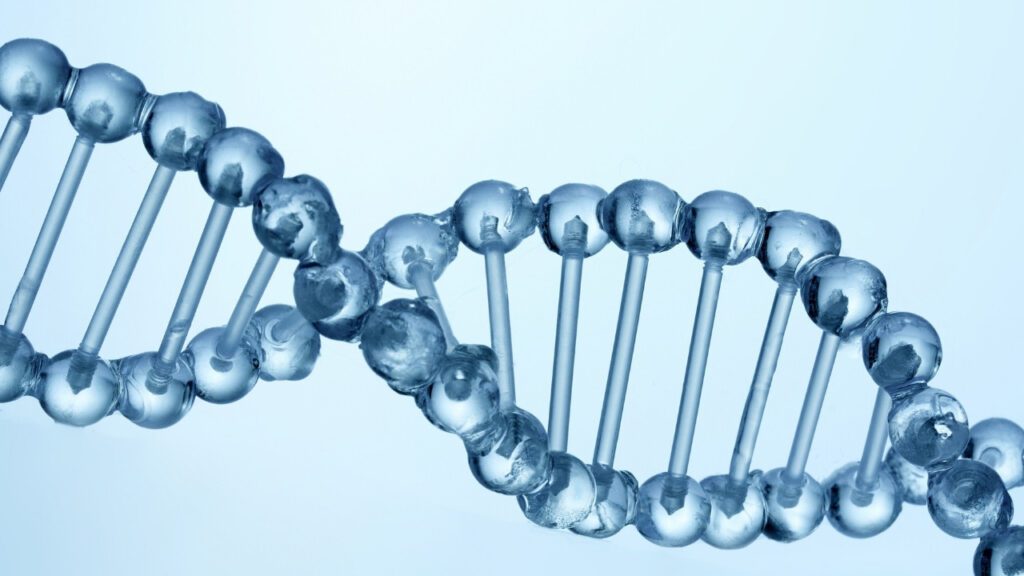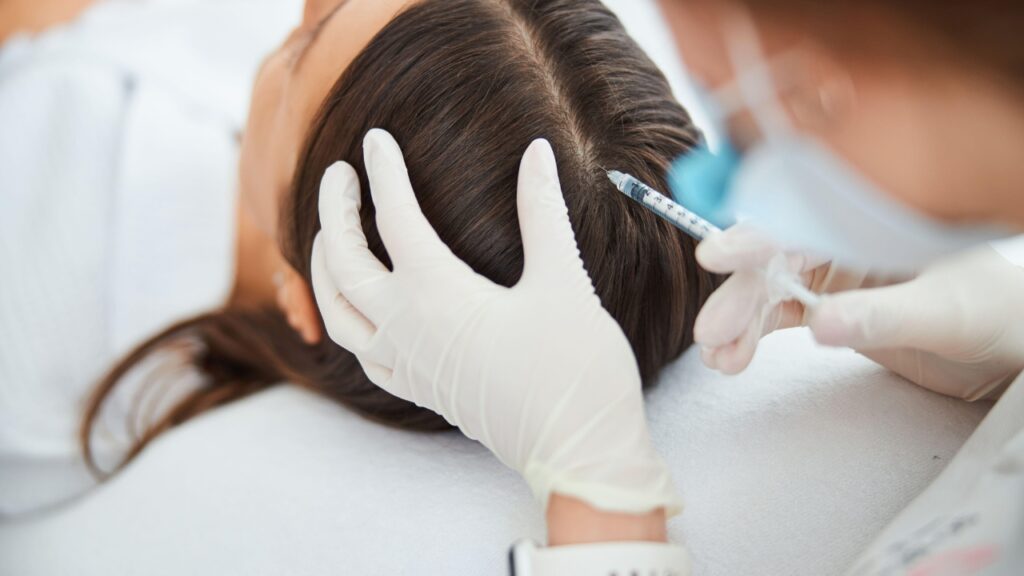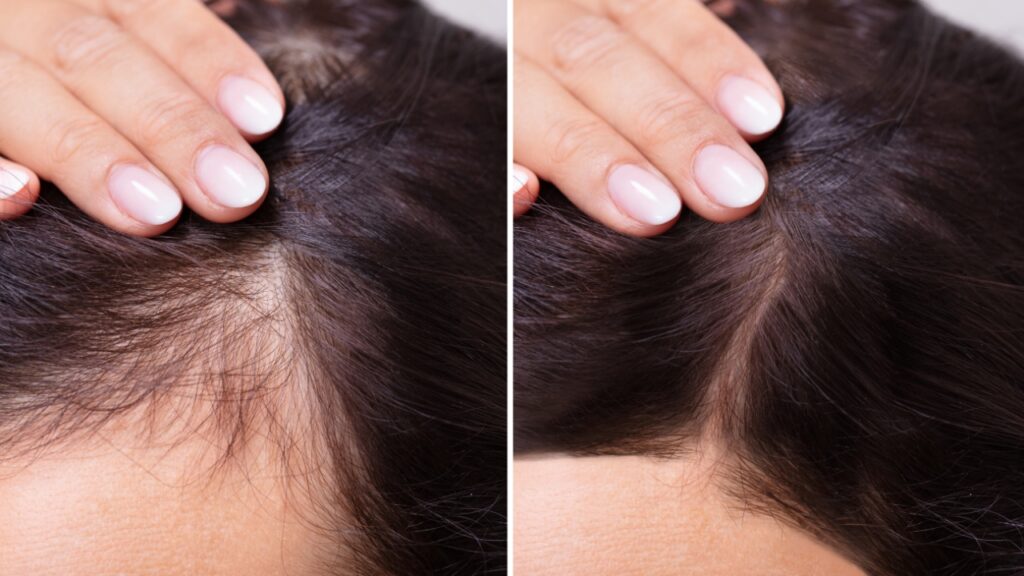Polynucleotide hair treatments are quickly becoming one of the most advanced non-surgical hair growth treatments. The procedure uses DNA fragments to rejuvenate the scalp and stimulate natural hair regrowth. This cutting-edge therapy promotes tissue regeneration and collagen induction, creating a biologically active environment for hair growth.
Therefore, this guide explores what is polynucleotide treatment for hair restoration.
What is Polynucleotide Treatment for Hair Loss?
Polynucleotide treatment for hair loss involves the use of polynucleotide scalp injections. These are biocompatible, DNA-derived molecules composed of long chains of nucleotides (the building blocks of DNA and RNA).
These natural molecules trigger the body’s repair mechanisms, increasing tissue regeneration and blood flow to the scalp. This creates a healthier environment around the hair follicles, which promotes natural hair regrowth.

Polynucleotides also stimulate collagen induction in the scalp. This is where the body produces more collagen, which strengthens the skin and supports follicle structure. The improved scalp health reactivates dormant or underperforming follicles, leading to stronger and thicker strands over time.
Unlike traditional treatments, polynucleotide scalp injections actively promote DNA-based hair restoration. This enhances the body’s natural healing processes. The approach is also safe and effective, as it uses biocompatible materials. This makes it ideal for individuals seeking non-surgical hair growth treatments.
How Does Polynucleotide Treatment Work?
Most people often ask, “How do polynucleotide scalp injections work to regrow hair?” The injections work by initiating natural hair regrowth through a multi-step biological process. Once injected into the dermis of the scalp, these DNA fragments activate cellular regeneration, microcirculation, and collagen induction. This creates a nourishing microenvironment that heals damaged hair follicles and supports new growth.

Polynucleotides possess anti-inflammatory properties, which reduces scalp inflammation and oxidation, key causes of thinning hair. They also improve blood circulation in the scalp, ensuring the hair follicles receive adequate nutrients and oxygen. Moreover, enhanced collagen and elastin production strengthen the scalp structure, supporting hair follicles.
Benefits of Polynucleotide Hair Regrowth Therapy
PN hair regrowth therapy is popular for its ability to rejuvenate the scalp and address hair loss. Unlike traditional solutions that only address symptoms, polynucleotide therapy works at the cellular level to improve the scalp’s biological environment. This makes it effective for individuals with thinning hair, postpartum hair loss, and early signs of androgenetic alopecia.
Key benefits include:
- Promotes natural hair regrowth by stimulating dermal papilla cells and activating dormant follicles.
- Supports collagen induction and scalp elasticity, promoting healthy hair.
- Improved blood flow to the scalp encourages growth of thicker strands, which improves overall hair density and volume.
- Reduces scalp inflammation and oxidative stress, key causes of follicular degradation and hair thinning.
- Ideal for women experiencing postpartum hair loss, as it helps restore hair during the recovery period.
- It can stimulate regrowth in scarred areas, such as post-surgery or post-trauma sites, through improving microcirculation and cellular turnover.
How Long Do the Effects of Polynucleotide Hair Injections Last?
The effects of polynucleotide treatment for hair restoration typically last 6-12 months. However, this duration depends on individual factors like age, genetics, and the underlying cause of hair loss. Most patients begin to notice visible improvements after 2-3 sessions. A full therapy generally involves 3-6 treatments, spaced 2-6 weeks apart.
Maintenance sessions every 6 months are highly recommended to preserve regrowth. The treatment also has minimal downtime, allowing patients to resume normal activities almost the same day. However, patients should avoid washing their hair or using hair products for 24 hours.
Polynucleotide Treatment for Hair Loss: Before and After
The following before and after images show the hair transformation after the polynucleotide scalp injections.

Who is Suitable for Polynucleotide Treatment?
Polynucleotide treatment for hair loss is a biologically active, regenerative therapy that offers excellent results. However, this is only possible when administered to the right candidates. Therefore, this therapy is best suited for:
- Individuals experiencing hair loss due to androgenetic alopecia, hormonal imbalances, or stress-induced shedding.
- Those with scarred scalp, especially post-trauma or surgery. PN hair regrowth therapy promotes tissue regeneration, making it effective in stimulating growth in areas affected by scarring.
- Women experiencing postpartum hair loss or telogen effluvium.
The treatment is not suitable for individuals with complete baldness or those with severe alopecia areata. Therefore, a thorough clinical assessment is necessary to examine the cause of the hair loss and determine the suitable treatment.
What If Polynucleotide Treatment Isn’t Right for You?
Individuals with advanced hair loss may seek alternative hair loss management solutions with equally effective results. The most well-known treatments include:
- PRP (Platelet-Rich Plasma) Therapy: The method uses a platelet concentration from the body’s blood to stimulate hair follicle activity. The PRP is injected directly into the scalp to enhance follicle vitality and promote natural hair regrowth.
- Exosome therapy: Exosomes are nanovesicles derived from stem cells that carry genetic signals and proteins to regenerate tissue. When applied to the scalp, they stimulate cell communication and enhance follicle function.
- FUE hair transplantation: Those with permanent hair loss can go for FUE hair transplantation, as it offers a permanent solution when done correctly.
Here is the summary table for the common hair treatments:
| Treatment type | Source | Working mechanism |
| Polynucleotide therapy | Synthetic DNA fragments | Stimulates tissue regeneration, increases collagen induction. |
| PRP therapy | Platelets from your blood | Provides growth factors to revitalise follicles. |
| Exosome therapy | Stem cell-derived vesicles | Enhances cell communication and regeneration |
| FUE hair transplantation | Surgical | Transplant live hair follicles from the donor area. |
Polynucleotides and exosomes are synthetic and biotechnology-based products that maintain a high level of purity and quality across all patients. Meanwhile, the success of PRP (platelet-rich plasma) is highly individualised and dependent on your body’s natural health status. Therefore, combining two or three therapies can yield better results if you are uncertain of which option to choose.
Trusted Polynucleotides Treatment for Hair Restoration in London: Dr. Michael O’Gorman
When it comes to expert-led polynucleotide treatment for hair restoration, Dr Michael O’Gorman wins for his exceptional patient-focused care. With over two decades in aesthetic and regenerative medicine, he combines scientific precision with a deep understanding of hair biology. This allows him to deliver highly effective PN hair regrowth therapy with safe results.
Dr O’Gorman offers treatment plans tailored to each patient’s hair loss type and scalp condition. Book your consultation today to receive a trusted, medically-backed solution, whether you are dealing with thinning hair or scarring. His clinic details are as follows:
- Address: 19 Wimpole Street, Marylebone, London W1 8GE
- Opening hours: Monday to Friday, 9 AM to 6 PM
- Booking: Consultations and quotes are available upon request. Visit the clinic website or call +447588385133 to schedule an appointment.








